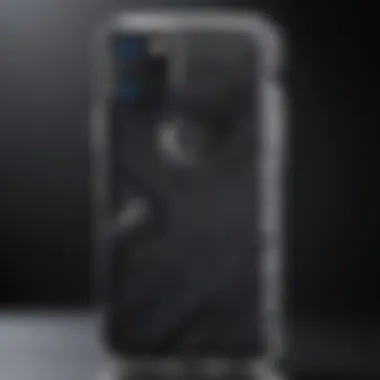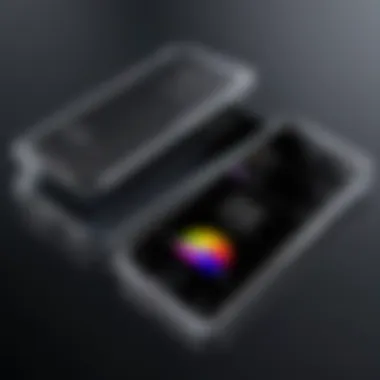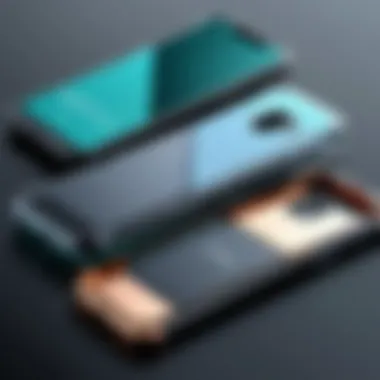The Ultimate Guide to Anti Peek Phone Cases for Privacy


Intro
In today’s digital era, privacy is a significant concern, especially when using smartphones. The growing reliance on mobile devices for communication and information access magnifies the need for protection against prying eyes. This creates a context where anti peek phone cases emerge as a viable solution. These cases are specifically designed to shield sensitive information on screens from onlookers, adding an essential layer of security to the user experience.
As we navigate through this article, we will explore various aspects of anti peek phone cases, including their designs, materials, and the advanced technologies that enhance privacy. We will also provide a comparative analysis against standard cases, allowing potential buyers to make informed choices tailored to their needs. By understanding the intricacies of these cases, readers can appreciate their value in maintaining personal privacy in a world that is rapidly growing more interconnected.
Product Overview
Brief Description
Anti peek phone cases serve a clear purpose: they help protect personal data from curious glances. The design integrates filters that restrict the visibility of the screen content to a narrow viewing angle. The objective is to prevent unauthorized viewing while still allowing the user to comfortably access their device.
Key Features
- Privacy Filters: Utilizes advanced technology for limiting visibility, ensuring only the user can see the screen content clearly.
- Durable Materials: Made from robust materials that provide protection against drops and scratches.
- Custom Fit: Designed to fit specific phone models, ensuring maximum effectiveness and usability.
Available Variants
Various manufacturers offer different styles of anti peek cases, designed for popular phone models like the iPhone 14, Samsung Galaxy S23, and others. These variants may vary in terms of materials, colors, and additional protective features.
Specifications Breakdown
Technical Specifications
Anti peek cases typically showcase varying levels of protection and features. Most are made from polycarbonate or TPU, providing a good balance between durability and flexibility.
Performance Metrics
- Viewing Angle Limit: Most cases restrict viewing to about 30 degrees on either side.
- Impact Resistance: Capable of withstanding drops of approximately 4 feet without significant damage.
Compatibility Information
When selecting an anti peek case, it is important to ensure compatibility with your specific phone model. Many cases are tailored to fit specific brands like Apple, Samsung, and Google devices.
Comparative Analysis
Competing Products
In the market, several cases provide varying levels of privacy protection. Competitors include Case-Mate, OtterBox, and Spigen, each with unique features.
Strengths and Weaknesses
- Strengths: Excellent privacy enhancement, durability, and sleek designs.
- Weaknesses: Can be bulkier than standard cases, may affect touch sensitivity in some designs.
Price Comparison
The price for anti peek phone cases can vary widely. Typically, they range from $20 to $60, depending on the brand and features included. Cheaper options may sacrifice certain protective qualities.
Buying Guide
Target User Profiles
Individuals who frequently use their devices in public spaces, like commuters, office workers, and travelers, are prime candidates for these cases. For those who prioritize privacy, especially professionals handling sensitive data, an anti peek case is worthwhile.
Important Considerations
When choosing an anti peek phone case, consider factors such as:
- Screen Size
- Material Quality
- Weight and Bulkiness
Insider Tips for Buyers
- Read reviews thoroughly to gauge performance.
- Check for warranty and return policy before purchase.
- Compare prices across multiple platforms for the best deal.
Maintenance and Upgrade Insights
Regular Maintenance Practices


Keep the case clean and inspect for wear and tear periodically. This ensures continued protection and effectiveness in preventing unauthorized viewing.
Upgrade Paths and Options
When upgrading phones, look for anew anti peek case compatible with the new model to maintain privacy features.
Troubleshooting Common Issues
If screen visibility is compromised, ensure no dust or debris is on the case or phone screen. If deformation occurs, consider replacing the case to ensure privacy levels are maintained.
Anti peek phone cases represent a growing demand for enhanced mobile privacy, effectively addressing the complexities of our interconnected lifestyles.
Understanding Anti Peek Technology
Understanding Anti Peek Technology is crucial in today’s context where privacy concerns are at the forefront due to our constant connectivity. As more individuals engage with their smartphones in public settings, the need for safeguarding sensitive information becomes increasingly important. Anti peek phone cases emerge as a proactive measure, allowing users to maintain their privacy against prying eyes.
Defining Anti Peek Phone Cases
Anti peek phone cases are specifically designed to protect the content of your device from being viewed by others without permission. They often incorporate advanced materials and technology that limits the angle from which the screen can be seen. This is particularly beneficial in scenarios where individuals are using their devices in crowded places like cafes, public transport, or during business meetings.
The technology behind anti peek cases often utilizes specialized layers of privacy filters that work seamlessly with the phone’s display. Unlike standard cases, which primarily focus on physical protection against drops and scratches, anti peek cases focus on visual obfuscation. The design aims to create a barrier to unauthorized viewing while still allowing the legitimate user direct access to the screen.
The Necessity of Privacy Protection
The necessity of privacy protection in the digital age cannot be overstated. With the proliferation of sensitive data on personal devices, such as banking information, personal messages, and private photos, the risk of privacy violations has escalated. User awareness regarding digital privacy is gaining attention, leading to a demand for effective solutions like anti peek phone cases.
These protective cases not only serve to block viewing angles, but they also help in preventing visual hacking, a term that refers to the practice of observing someone’s screen without their knowledge. By investing in an anti peek case, users take a vital step towards securing their personal information from unwanted eyes. This technology is essential for various groups, including tech enthusiasts, gamers, and professionals who handle sensitive information regularly.
Privacy is not a luxury; it is a fundamental requirement in a connected world.
Mechanics of Anti Peek Design
The mechanics of anti peek design play a crucial role in how these cases function and serve their primary purpose—protecting user privacy. These designs are not merely aesthetic; they are rooted in the application of specific materials and technologies that work together to create effective barriers against unwanted visual access to the device's screen. Through this section, we will delve into the material composition, functionality, and innovative technologies that define anti peek phone cases, highlighting their significance in the realm of mobile privacy.
Materials Used in Anti Peek Cases
The substance of anti peek phone cases lies largely in the materials utilized in their construction. The following discusses three core materials that define the functionality and effectiveness of these cases:
Polycarbonate
Polycarbonate is a favored material for anti peek phone cases due to its high durability and impact resistance. One key characteristic of polycarbonate is its lightweight nature, which does not add unnecessary bulk to the device. The unique feature of polycarbonate is that it can be formulated with a specific tint that provides visibility reduction from certain angles, making it challenging for bystanders to peep at sensitive information.
Advantages:
- Strong impact resistance ensures the phone's protection.
- Lightweight, enhancing usability without compromising aesthetics.
Disadvantages:
- The tint may affect color accuracy when viewing the screen directly.
Tempered Glass
Tempered glass is another material gaining traction in the anti peek category, primarily known for its sleek look and high clarity. The main trait of tempered glass is its ability to withstand scratches and impacts far better than regular glass. It can also incorporate anti glare and privacy features, reducing visibility from the sides while maintaining clarity when viewed from the front.
Advantages:
- High transparency provides a clear view of the screen.
- Can be designed to absorb shocks and resist scratches.
Disadvantages:
- More fragile compared to polycarbonate; a hard drop might cause cracks.
Privacy Film
Privacy film is a critical element that enhances the functionality of anti peek cases. This film works by limiting viewing angles, allowing only the person directly in front of the screen to see its content. The key characteristic of privacy film is its thinness, which does not hinder screen responsiveness. A unique feature of privacy film is its ability to be applied over existing screens without affecting their overall sensibility or clarity.
Advantages:
- Allows for maximum screen sensitivity and clarity.
- Thin layer does not add bulk to the case design.


Disadvantages:
- May wear off over time, reducing effectiveness and requiring replacement.
Integration of Privacy Filters
The integration of privacy filters is pivotal in ensuring that anti peek phone cases serve their intended purpose. These filters work alongside the previously mentioned materials to further inhibit viewing angles and provide an additional layer of protection against prying eyes. This technology is often combined with surface coatings that enhance the case's resilience against scratches and other damage.
Lens Technology in Case Design
Lens technology significantly alters how anti peek cases operate. By incorporating specialized lens components, manufacturers can manipulate the light that emits from the screen, enhancing privacy without compromising clarity. These innovations also seek to balance the need for visual accessibility with the necessity for privacy, making the user experience more satisfactory.
In an era characterized by increased connectivity and digital interaction, the mechanics of anti peek phone design cannot be overstated. The effectiveness of these materials and technologies plays a vital role in protecting personal information from unauthorized observers.
Benefits of Using Anti Peek Phone Cases
Anti peek phone cases offer notable advantages, addressing key concerns in today's digital environment. With increasing reliance on mobile devices, privacy has become a fundamental issue. These cases do more than just protect phones from physical damage; they serve as a barrier against unwanted visual intrusion. This section explores three primary benefits of using anti peek phone cases: enhanced privacy in public spaces, protection against visual hacking, and the aesthetic value of modern design.
Enhanced Privacy in Public Spaces
One significant advantage of anti peek phone cases is the enhanced privacy they provide, particularly in crowded environments. When using smartphones in places like coffee shops or public transport, screens can be easily viewed by people nearby. Anti peek technology mitigates this risk effectively. The design of these cases often includes specialized materials that limit viewing angles, ensuring that only the user can see the content displayed on their device.
This technology is crucial in situations where sensitive information is involved. Bank statements, private messages, or confidential business communications can be shielded from prying eyes. By maintaining privacy, users have more freedom to operate their devices without concern. Anti peek cases create a safer digital environment in an increasingly interconnected world.
Protection Against Visual Hacking
Visual hacking is a growing concern, defined as the unauthorized observation of a device's screen to capture confidential information. Anti peek phone cases act as an effective line of defense against such threats. The privacy filters built into these cases make it difficult for onlookers to steal information that may otherwise be readily visible.
This added layer of security is important for professionals who frequently handle sensitive data. For instance, a financial analyst might use their phone to check stock prices or client accounts. With anti peek technology, they can do so without fear of being compromised by nearby individuals. As our lives become more digital, the need for such protections will likely increase, making these cases an essential consideration for security-conscious users.
Aesthetic Value and Modern Design
In addition to functionality, anti peek phone cases often embrace modern design principles, catering to user preferences for style and aesthetics. Many users desire accessories that reflect their personal taste while providing practical benefits. Fortunately, today's market offers a range of designs, colors, and finishes, allowing individuals to choose cases that suit their styles without sacrificing privacy.
From sleek minimalistic models to bold patterns, the options vary widely. Some manufacturers even collaborate with designers to introduce exclusive collections. This intersection of functionality and aesthetic appeal makes anti peek phone cases not only protective tools but also fashion statements. As a result, users can maintain privacy and showcase their personalities simultaneously.
"Anti peek cases combine the necessity of privacy with the art of personal expression."
Comparing Anti Peek Cases and Standard Cases
Anti peek phone cases represent a significant shift in consumer technology, prioritizing privacy in mobile devices. By comparing these specialized cases to standard ones, we gain insights into functionality, usability, durability, and costs. This understanding helps consumers make informed choices. Given the growing dependence on smartphones, evaluating the benefits of anti peek technology is essential.
Functionality and Usability
Functionality is a key aspect when examining anti peek cases versus standard models. Anti peek phone cases often include integrated privacy features. These features typically prevent unintended viewing from angles beyond a certain threshold. For everyday use, this means that only the device owner can see the content on the screen clearly.
On the other hand, standard cases generally focus on protection from damage rather than privacy. Their designs allow for unrestricted viewability for anyone positioned near the device.
Additionally, the usability of anti peek cases may vary. Some models might add extra thickness compared to standard cases, potentially affecting the ergonomics of handling the phone. It's important to evaluate how these aspects align with daily routines. Those who often use their devices in crowded or public spaces might find the added privacy of anti peek cases invaluable.
Anti peek technology provides the peace of mind that your conversations and information remain private, enhancing user confidence.
Durability and Material Quality
When comparing durability and material quality, anti peek cases can hold an edge due to their advanced construction. Common materials like polycarbonate and tempered glass are often chosen for their resilience. They offer strong protection from impacts and scratches while maintaining transparency for the privacy filters to function effectively.
In contrast, standard cases range widely in quality, from low-cost plastic options to more robust leather varieties. The choice of material can significantly affect longevity and the level of protection offered. A well-made anti peek case should not only protect against scratches and drops but also endure the test of time with its privacy features intact.
Consumer preferences may vary, but many prioritize durability. Investing in a well-constructed anti peek case may prove more economical in the long term compared to replacing standard cases frequently.
Cost Analysis
Cost is always a factor when purchasing a phone case. Anti peek cases can be more expensive than standard options due to their specialized technology and materials. However, the enhanced privacy features often justify the higher price. Many consumers see it as an investment in personal security because the risk of unauthorized viewing of sensitive information is mitigated.
Standard cases, while more budget-friendly, do not offer the same level of protection regarding visual access. Thus, it's critical for consumers to analyze what they are spending their money on.
In summary, while anti peek cases may involve a higher upfront cost, the value of privacy and protection they provide can lead to greater savings over time. Consumers should weigh their options carefully and consider how much they value enhanced privacy when making their choice.
Consumer Considerations When Choosing Anti Peek Cases


Understanding the significance of anti peek phone cases is integral for anyone aiming to enhance their mobile privacy. As technology advances, so does the complexity of privacy concerns. Consumers have to consider various aspects before choosing an anti peek case. This section delves into three critical factors: device compatibility, personal style and preferences, and brand reputation and reviews.
Device Compatibility
When selecting an anti peek case, device compatibility is arguably the most fundamental aspect to address. Each phone model has unique dimensions and placements for buttons, cameras, and ports. Thus, ensuring that the chosen case fits correctly is essential for protecting the device while maintaining usability.
A case designed for specific brands like Apple, Samsung, or Google Pixel guarantees that all features remain accessible. If a case does not fit the phone properly, it can lead to frustration and compromised protection. Additionally, some manufacturers may offer various models of the same case, catering to different variants of a phone series. For example, an iPhone 14 case may differ significantly from an iPhone 14 Pro case.
In summary, verifying compatibility with the intended device is crucial.
Personal Style and Preferences
While functionality and protection are primary concerns, personal style also plays a vital role in consumer choices. Many users want a case that reflects their personality or complements their lifestyle. Anti peek phone cases come in various designs, colors, and textures; thus, they can serve both protective and aesthetic purposes.
The design flexibility among brands encourages individuality. Consumers can select from simple, minimalistic designs or more elaborate patterns and textures. Some cases may employ a sleek finish, while others might feature a rugged feel suitable for outdoor use. The decision ultimately lies in matching a case that suits one’s style while still providing robust privacy protection.
In addition to visual appeal, the material of the case can influence the tactile experience. Selecting a case that is easy to grip can enhance comfort while using the phone, further impacting daily utility.
Brand Reputation and Reviews
Brand reputation can significantly sway consumer decisions. As with most products, well-established brands tend to have a reliable history, which can reassure buyers about their purchase. When choosing an anti peek case, researching brand reputation becomes paramount for insight into durability and effectiveness.
Consumer reviews often provide a wealth of information. Potential buyers should look for feedback on the actual performance of the privacy technology, durability over time, and any design flaws that could interfere with the functionality. More recent reviews are particularly useful as they reflect current product iterations and improvements.
Reputable sources such as Reddit, tech blogs, or customer sections on retail sites can offer unbiased opinions. Investigating these resources can enrich the buyer’s understanding, ensuring an informed decision when selecting an anti peek phone case.
Future of Anti Peek Technology
The landscape of mobile privacy is constantly shifting. This section examines the future of anti peek technology, underlining its significance in an age where data breaches and unauthorized access are prevalent. As society becomes more digital, protecting personal information on mobile devices is critical. Anti peek cases represent a pioneering approach to safeguarding information, and understanding upcoming trends and developments is essential for tech-savvy users.
Emerging Trends in Mobile Privacy
As awareness of digital privacy grows, new trends emerge in mobile safety, especially concerning anti peek technology. Users now demand products that not only offer physical protection but also enhance privacy.
Key trends include:
- Increased Use of Biometric Access: Biometrics is gaining traction. With fingerprint sensors and facial recognition, users seek cases that integrate with these security features while protecting the device's screen from prying eyes.
- Smartphone Customization: Consumers value personalized protection solutions. Companies focus on creating anti peek cases that can be tailored, ensuring style does not compromise security.
- Focus on User Education: Manufacturers are emphasizing the importance of digital literacy. Educating users about privacy issues and the tech behind anti peek designs enhances product value.
Emerging trends underscore a collective movement towards advanced privacy measures.
Advancements in Material Science
Material science is an integral part of the evolution of anti peek technology. Innovations in materials not only enhance durability but also improve privacy features.
Some notable advancements include:
- Nano-structural Materials: Nano-coating can now be applied to create screens that obscure visibility from side angles without sacrificing clarity.
- Hybrid Materials: Combining various materials such as polycarbonate and tempered glass leads to enhanced protective qualities that are also lightweight.
- Environmentally Friendly Materials: As sustainability becomes a priority, manufacturers explore eco-friendly options that still offer robust protection against visual interference.
These advancements are crucial for developing efficient, aesthetically pleasing, and environmentally sustainable products.
Potential Impacts on Consumer Behavior
As anti peek technology advances, it inevitably shapes consumer behavior. Users gradually become more intentional regarding their product choices, reflecting a shift towards privacy-focused decisions.
Considerable impacts include:
- Increased Demand for Privacy Features: Users are prioritizing cases that emphasize visual protection. They recognize the value of anti peek features in maintaining confidentiality.
- Awareness of Brand Credibility: Customers conduct thorough research on brands that prioritize security. They favor reputable companies that prove their commitment to consumer privacy.
- Shift Towards Comprehensive Security Solutions: Consumers are likely to seek holistic solutions combining anti peek cases with other privacy measures, such as software security features and encrypted messaging apps.
Consumer choices now reflect a deeper understanding of privacy's role in daily life. Companies must adapt to this evolving landscape if they wish to succeed.
“The future of privacy-tech is not just about protection, but also empowerment.”
The trajectory of anti peek technology indicates a promising outlook. Innovations in material science and growing consumer awareness are bound to shape the market, leading to enhanced security options for users.
The End
Summary of Key Points
In this article, we have explored the intricate world of anti peek phone cases, emphasizing their role in enhancing privacy in our technology-driven lives. Key points include:
- Understanding Anti Peek Technology: Anti peek cases utilize specialized design to keep your screen contents private from unauthorized viewing.
- Mechanics of Anti Peek Design: Various materials like polycarbonate and tempered glass, combined with advanced privacy filters, contribute significantly to their functionality.
- Benefits of Using Anti Peek Phone Cases: These cases not only protect personal information but also offer durability and aesthetic appeal.
- Comparing Anti Peek Cases to Standard Cases: The differences in functionality, usability, and material quality delineate a clear advantage for anti peek solutions, despite varying costs.
- Consumer Considerations: Factors such as device compatibility and brand reputation can influence the decision-making process when selecting a suitable case.
- Future of Anti Peek Technology: The emergence of new trends in mobile privacy and material science has potential impacts that can further shape consumer behavior.
Final Thoughts on Mobile Privacy
Mobile privacy is more critical now than ever. With increasing incidents of visual hacking and data theft, the need for effective protective measures becomes apparent. Anti peek phone cases serve a dual purpose—offering privacy while ensuring the physical protection of devices. As technology continues to evolve, so too should our understanding and approaches to safeguarding personal information. In this context, anti peek phone cases stand out as a proactive measure for those who value their digital security. Therefore, equipping devices with such cases not only reflects an awareness of current challenges but also a commitment to personal privacy and security. Being informed and conscious about the tools available is essential for maintaining control in a connected world.



